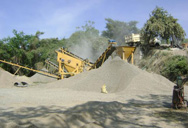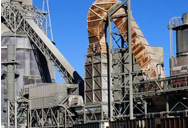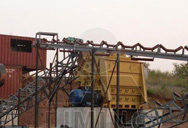


2020-3-23 A blast furnace (BF) is the dominant process for making iron in the world. The BF is charged with metallurgical coke and iron burden materials including iron ore pellets, sinter, and lump ore. While descending in the BF the charge materials reduce.
Read More
2020-1-30 Reduction degrees as a function of time in all studied temper-atures (700, 800, 900, and 1000 C) for iron ore pellets, sinter, and lump ore are shown in Figure 3. It is shown that the lump ore has the slowest reduction rate at each studied temperature. Pellets were the fastest to reduce in 700 C, but already at 800 C,
Read More
2020-10-26 The reduction of iron ore–coal composite pellet is a complex process that involves non-uniform heat and mass transfer. Several reactions taking place simultaneously during the reduction of iron ore–coal composite pellet are as follows: [ 6, 7]
Read More
2009-5-11 DRI or Sponge Iron is a porous solid-state product of direct reduction process, which is produced either in lump or pellet form. DRI is a good substitute for steel scrap for producing steel in EAF, BOF etc, which resulted a rapid growth of the sponge Iron Industry. In view of increasing demand of sponge Iron in the manufacturing of different variation of steel, a good deal of emphasis is being given
Read More
2014-3-1 The diffusion of CO and H 2 through the pellet resulting from the pyrolysis of PKS produces favourable conditions for the reduction of iron oxide inside the pellet. Basically, the reduction rate of iron ore is higher when hydrogen is used compared to other gases and the reduction can proceed at low temperatures , . Thus, the presence of hydrogen might be the most reactive among the reducing
Read More
2018-7-11 The iron ore pelletizing process consists of three main steps: Pelletizing feed preparation and mixing: the raw material (iron ore concentrate, additives—anthracite, dolomite—and binders are prepared in terms of particle size and chemical specifications, dosed, and mixed together to feed the pelletizing process;
Read More
2016-12-29 The sized iron ore fines were mixed with bentonite (0.3 %) and required amount of fluxes to get desired pellet chemistry in a rotary cone mixer. The mixture was then pelletized with intermittent manual spray of water (7-9 %) for nucleation and growth of pellets in a disc pelletizer having 700 mm disc diameter with 30 rpm speed.
Read More
2018-7-17 Bentonite, an inorganic binder, has been the main binder used in the iron ore pelletizing process since the beginning of pellet production in the 1950s. Bentonite promotes the forma- tion of ceramic bridges between particles, which can minimize the number of pellets that collapse during firing.
Read More
2012-7-10 Iron ore in a finely ground state is not easily transported or readily processed .Thus it is necessary to agglomerate the fine ground ore into pellet using binders. Inorganic binders introduce silica which decreases the final ore content of the pellet. Hence organic binders were developed.
Read More
2020-10-1 The optimal reduction temperature of the rotary kiln should be controlled at 1150 °C to 1250 °C with pellet basicity of 0.56 to prevent the ring-forming phenomenon.
Read More
2019-8-22 pawelbrzoza / reduction-process-iron-ore-pellet. Notifications Star 0 Fork 0 0 stars 0 forks Star Notifications Code; Issues 0; Pull requests 0; Actions; Projects 0; Wiki; Security; Insights; master. Switch branches/tags. Branches Tags. Could not load branches. Nothing to show ...
Read More
HYL Process for Direct Reduction of Iron Ore IspatGuru. Apr 22, 2017 Energiron direct reduction process (HYL process) uses a shaft reduction furnace to produce DRI. It is designed to convert iron pellet/lump ore into metallic iron by the use of reducing gases in a solid-gas moving bed shaft furnace.
Read More
2016-12-29 porosity. Botelho et al.[ 13 ] invented a process of improving reducibility of iron ore by adding metallic Ni containing materials wherein, the catalytic effect for the reduction was generated by the addition of metallic Ni. Presence of Cr 3+ also increases the reducibility of iron
Read More
Reduction process Once that carbon monoxide is produced by Boudouard reaction, reduction of an iron ore pellet is divided in two steps3,4,5: a) Diffusion of CO through external core. b) Chemical reaction in external core/oxide interface. These steps correspond to a topochemical reduction following scheme on figure 1 which shows
Read More
2009-6-9 4.7 Effect of coal type on the degree of reduction of iron ore pellets 4.8 Comparison of reduction behavior Pellet and Lump ore 4.9 Evaluation of Activation Energy 4.10 Reduction behavior of pellets made by mixing iron ore fines of different sizes at different ratio 4.11 Effect of time on extent of swelling of iron ore pellet 4.12Effect of ...
Read More
2012-7-10 Iron ore from Gandha Mardana mines and charcoal were used in the experiment .Analysis of the iron ore showed that it contained 63.7%Fe, 1.6%SiO2, and 1.4% Al2O3. The reaction carried out in the experiment is mainly of direct reduction because here we have used charcoal. The iron ore was crushed, ground and screened to 100# size and charcoal to 72#
Read More
2017-4-22 Energiron direct reduction process (HYL process) uses a shaft reduction furnace to produce DRI. It is designed to convert iron pellet/lump ore into metallic iron by the use of reducing gases in a solid-gas moving bed shaft furnace. O2 is removed from the iron ore
Read More
the relation between pellet microstructure and reduction Influence of Oxide and Silicate Melt Phases on the RDI of Iron Ore Pellets Suitable for Shaft Furnace of Direct Reduction Process Srinivas DWARAPUDI1) and Madhu RANJAN2) 1) RD, Tata Steel, Jamshedpur, 831007 Jharkhand, India. E-mail: srinivasd@tatasteel
Read More
2012-5-1 His major researches are sintering and pelletizing and the novel process of direct reduction of iron ore pellets by coal gas. T. Jiang (born October, 1963), is a professor of iron and steel metallurgy at Central South University, and a vice president of academic committee of high-temperature metallurgy in the U.S. TMS (Minerals, Metals ...
Read More
2019-8-22 pawelbrzoza / reduction-process-iron-ore-pellet. Notifications Star 0 Fork 0 0 stars 0 forks Star Notifications Code; Issues 0; Pull requests 0; Actions; Projects 0; Wiki; Security; Insights; master. Switch branches/tags. Branches Tags. Could not load branches. Nothing to show ...
Read More
2016-12-29 porosity. Botelho et al.[ 13 ] invented a process of improving reducibility of iron ore by adding metallic Ni containing materials wherein, the catalytic effect for the reduction was generated by the addition of metallic Ni. Presence of Cr 3+ also increases the reducibility of iron
Read More
2010-6-18 Sponge iron that produced PT.Krakatau Steel is a raw material in the manufacture of steel that was previously carried out direct reduction process (Direct Reduction) with the raw material ore pellets. Direct reduction process is a process that aims to take the oxidation of iron ore by reduction using H2 and Co. reductant gas at temperatures ...
Read More
Reduction process Once that carbon monoxide is produced by Boudouard reaction, reduction of an iron ore pellet is divided in two steps3,4,5: a) Diffusion of CO through external core. b) Chemical reaction in external core/oxide interface. These steps correspond to a topochemical reduction following scheme on figure 1 which shows
Read More
2016-4-9 The reduction of iron ore pellets has been studied using different techniques. Thermodynamic studies, experi-mental investigations and mathematical modelling have all been undertaken to better understand the behaviour of different pellet types in the new direct reduction process. The mathematical pellet model gives a good fit to
Read More
Heat transfer analysis of iron ore spherical pellet in the direct reduction process. A Milandia 1, A Juniarsih 1, R Muadz 1 and A Sactianto 1. Published under licence by IOP Publishing Ltd Journal of Physics: Conference Series, Volume 1376, The 2018 International Conference on Engineering, Technologies, and Applied Sciences 18–20 October 2018, Bandar Lampung, Indonesia Citation A Milandia et ...
Read More
2017-2-6 Process Metallurgy Reduction Behaviour of Olivine Iron Ore Pellets in the Experimental Blast Furnace Si Hyung Lee1), Rita Khanna1), Bo Lindblom2), Mats Hallin2) and Veena Sahajwalla1) 1) Centre for Sustainable Materials Research and Technology, School of Materials Science and Engineering, University of New South Wales, Sydney, NSW2052, Australia, [email protected]
Read More
2017-4-22 Energiron direct reduction process (HYL process) uses a shaft reduction furnace to produce DRI. It is designed to convert iron pellet/lump ore into metallic iron by the use of reducing gases in a solid-gas moving bed shaft furnace. O2 is removed from the iron ore
Read More
2020-1-30 At DR-plants today, natural gas or syngas is used to reduce iron ore pellets into porous sponge iron. This process generates heat as the pellet is reduced. However, simple calculations show that by changing the natural gas into hydrogen, energy is consumed during the reduction process [4], [5]. The difference between the enthalpies for reducing ...
Read More
DRI production. Direct reduction of iron is the removal of oxygen from iron ore or other iron bearing materials in the solid state, i.e. without melting, as in the blast furnace. The reducing agents are carbon monoxide and hydrogen, coming from reformed natural gas, syngas or coal. Iron ore is used mostly in pellet and/or lumpy form.
Read More
